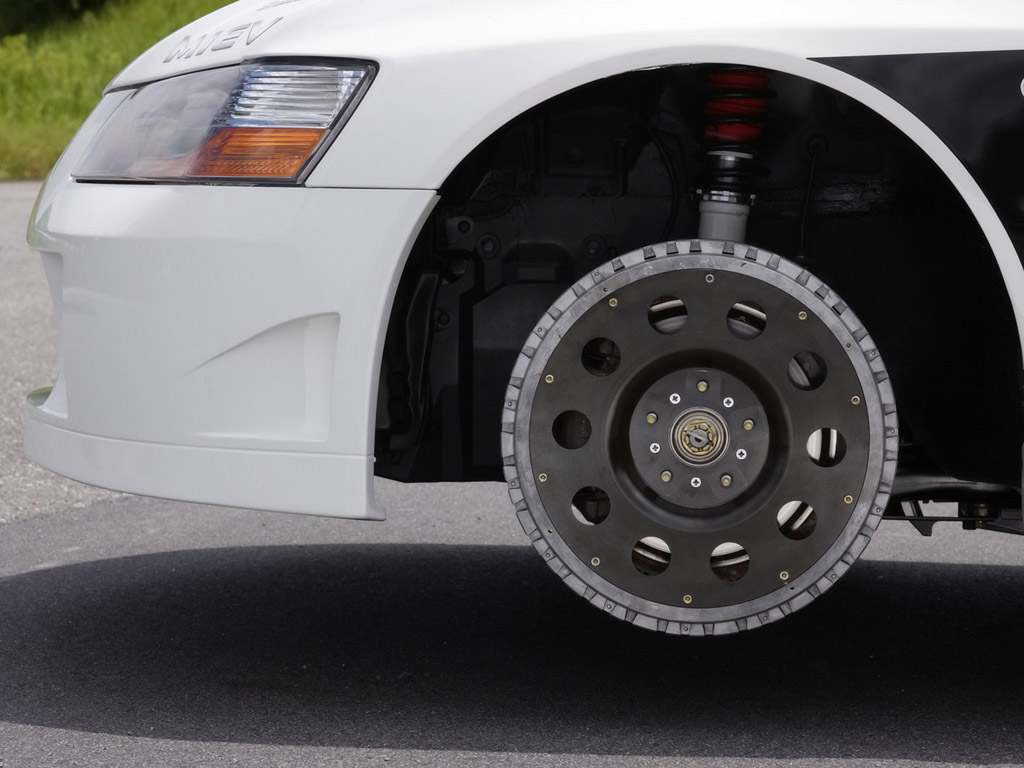2005 Mitsubishi Lancer Evolution IX MIEV
MIEV – a proposal for next-generation electric vehicles that utilizes to maximum effect the environmental technology Mitsubishi Motors has developed over the years. The offspring of a marriage between such environmental technology and Mitsubishi Motors’ sporty characteristics, Lancer Evolution MIEV delivers a totally new experience in driving pleasure.
Lancer Evolution MIEV derives from the Lancer Evolution IX. Utilizing the advantages offered by the electric powertrain to craft smooth and slippery, low-drag body lines, the styling imparts an aggressive wind-cleaving look to the body. Riding on large wheels and tires, Lancer Evolution MIEV projects a tempting taste of its potent new-age sport driving potential.
The wheels are driven by four outer-rotor in-wheel motors. Requiring no speed reducer, these high-efficiency direct drive motors fit neatly into the 20-inch wheels. Each in-wheel motor produces 50 kW of power and 518 Nm torque. With a motor in each wheel, this brings maximum output up to 268.2 bhp (200 kw). And because this drive system allows precise regulation of power at each individual wheel, it opens the door to creating a vehicle dynamics control system in its ultimate evolutionary form – one that could be dubbed Super All Wheel Control (S-AWC).
The in-wheel motors and the lithium-ion battery system, which is located under the floor to reduce the center of gravity, accelerate Lancer Evolution MIEV from 0 km/h to 100 km/h in less than 8 seconds and up to a maximum speed of 180 km/h. This is a level of motive performance that leaves today’s EV’s standing.
The foremost feature of the in-wheel motor is that it allows drive torque and braking force to be regulated with high precision on an individual wheel basis without requiring transmission, drive shafts, differential gears or other complex and heavy components. Housing the drive system in the wheels also gives greater freedom in designing the layout. This will facilitate the conversion of internal combustion engine-powered vehicles into hybrid vehicles without requiring the introduction of complex hybrid power systems. It will also make it easier to provide room for space-consuming components such as fuel cell stacks and hydrogen tanks in fuel cell vehicles. The space-saving benefits of the in-wheel motor also offer exciting possibilities in terms of body design.
The major shortcoming of the EV to date has been its limited cruising range. This is now well on the way to being overcome with recent improvements in battery performance. MIEV uses a lithium-ion storage cell for its main power source, this offers advantages in terms of energy density and life over other types of secondary or rechargeable battery.
Story by Mitsubishi
In Detail
| submitted by | Richard Owen |
| engine | Four Electric Engines w/Lithium-Ion Battery System |
| position | In-Wheel |
| fuel feed | Electronic Fuel Injection |
| power | 200.0 kw / 268.2 bhp |
| body / frame | Unit Steel |
| driven wheels | Super All Wheel Control (S-AWC). |
| front tires | P235/45R17 |
| rear tires | P235/45R17 |
| front brakes | Brembro Discs w/4-Piston Calipers, ABS, EBD |
| f brake size | x 320 mm / x 12.6 in |
| rear brakes | Brembro Discs w/Twin-Piston Calipers, ABS, EBD |
| r brake size | x 305 mm / x 12 in |
| front wheels | F 43.2 x 20.3 cm / 17 x 8 in |
| rear wheels | R 43.2 x 20.3 cm / 17 x 8 in |
| steering | Rack & Pinion w/Power Assist |
| f suspension | MacPherson Struts w/Bilstein Shock Absorbers, Trailing Links, Lateral Links, Stabilizer Bar |
| r suspension | Mulit-Link w/Bilstein Shock Absorbers, Trailing Links, Lateral Links, Stabilizer Bar |
| curb weight | 1490 kg / 3285 lbs |
| wheelbase | 2625 mm / 103.3 in |
| front track | 1515 mm / 59.6 in |
| rear track | 1515 mm / 59.6 in |
| length | 4535 mm / 178.5 in |
| width | 1770 mm / 69.7 in |
| height | 1450 mm / 57.1 in |
| transmission | No Transmission |
| gear ratios | :1 |
| 0 – 100 mph | ~7.9 seconds |







